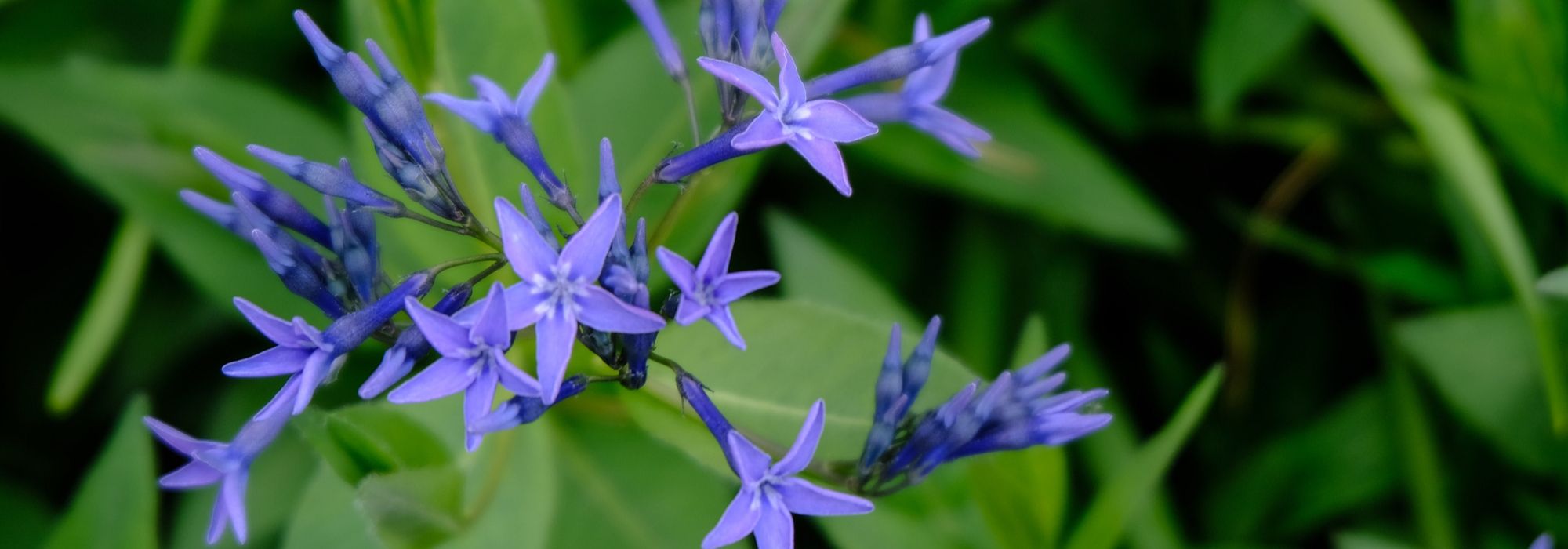
Amsonia, blue star: planting and care
Contents
Amsonia in a nutshell
- Amsonia is an excellent perennial for partial shade
- It has airy yet vigorous foliage that takes on beautiful golden tones in autumn
- Like Amsonia ‘Blue Ice’, its clusters of blue, star-shaped flowers bloom abundantly from May to September, for several weeks
- Hardy and low-maintenance, it grows easily in good garden soil that does not dry out too much in summer
- It will bring country charm to flower beds and borders in a natural garden
A word from our expert
Amsonia is sometimes called “blue amsonia” or “blue star” and is an attractive perennial with generous star-shaped blue flowering exemplified by the magnificent cultivar ‘Blue Ice’. With delicate foliage that often takes beautiful golden tones in autumn, it will bring plenty of lightness and charm to the garden.
In the garden, you will appreciate Amsonia hubrichtii with its very fine foliage often taking golden tones in autumn, Amsonia orientalis with delicate blue-violet flowers, Amsonia tabernaemontana and its Var. salicifolia with willow-like leaves, Amsonie ciliata or Amsonia illustris with steel-pale blue flowers.
This graceful plant is easy to grow in full sun or partial shade, in any good garden soil provided it is not too dry in summer.
It is very hardy, never troubled by disease and deserves its place in the natural, wild, or romantic gardens!
Description and botany
Botanical data
- Latin name Amsonia
- Family Apocynaceae
- Common name Amsonia, blue amsonia, blue star
- Flowering May to September
- Height 0.30 to 1.50 m
- Exposure Sun, partial shade
- Soil type well-drained, light
- Hardiness below -15°C
Amsonia is a semi-shrubby perennial plant of family Apocynaceae, like periwinkles, oleander and Mandevillas. It originates mainly from meadows, woodland and sandy areas or fresh woodland edges of United States, and sometimes from Greece and Turkey.
The genus includes 22 species of perennials and bushes including Amsonia tabernaemontana, broadleaf amsonia also called “blue amsonia” or “blue star” and its cultivars and hybrids ( Amsonia tabernaemontana var. Salicifolia, Amsonia ‘Blue Ice’) which are most commonly grown in gardens. Amsonia ciliata, amsonia with feathery foliage, and its more compact subspecies Amsonia ciliata filifera, Amsonia hubrichtii and eastern amsonia (Amsonia orientalis) are also attractive species for gardens.
From a more or less lignified stump, these herbaceous perennials form over time beautiful bushy, erect and very supple clumps, which can reach 1 m depending on species. Amsonia can take a little time to establish in garden, taking around 2 to 5 years after planting to flower well, but once well rooted it shows great longevity.
Plant stands out by its abundant foliage, both light and graceful, which differs according to species. Stems exude a milky sap when broken and bear deciduous leaves that are more or less narrow. Leaves are alternate, ovate to lanceolate, with a central vein and 5 to 10 cm long. Amsonia hubrichtii is distinguished by very fine needle-like leaves, Amsonia orientalis bears willow-like leaves while Amsonia ciliata produces very fine leaves fringed along the lamina with numerous hairs when juvenile.

Amsonia tabernaemontana
Bright green, slightly acid green to dark green, this foliage takes in most amsonias beautiful autumn colours, turning golden-yellow, orange or golden-bronze before falling.
From May to September depending on climate, flowers emerge abundantly and are clearly visible above this elegant, sometimes feathery foliage, but always attractive even outside flowering period. Flowers are grouped in pyramidal panicles, borne at tip of erect stems. Flower buds bristly with white hairs open into small star-shaped tubular flowers 2 to 3 cm wide. Corolla consists of five narrow pointed petals fused into an elongated tube and set in a villous calyx.
These erect flower spikes display a whole palette of blues, from very luminous pale lilac-blue, to sky blue through to deepest steel-blue (Amsonia ‘Blue Ice’).
Very melliferous, flowers attract throughout summer butterflies, bees and other pollinating insects. Their flowers are very pretty in fresh, delicate summer bouquets.
After flowering, Amsonia produces small dehiscent pods containing winged seeds, fairly decorative.
Very hardy below -15°C, Amsonia grows in all our gardens, in non-scorching sun or partial shade in soil that stays cool during growing season. It is an essential plant in wild and naturalistic gardens, easy to plant in a perennial bed or a mixed border, where it will bring lightness and rustic charm alongside other summer-flowering perennials.
Main species and varieties
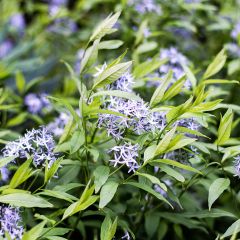
Amsonia tabernaemontana var. salicifolia
- Flowering time July, August
- Height at maturity 80 cm
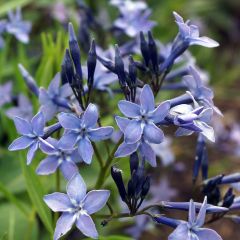
Amsonia Blue Ice
- Flowering time June to August
- Height at maturity 35 cm
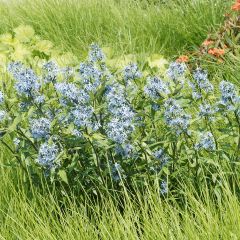
Amsonia ciliata
- Flowering time July
- Height at maturity 75 cm
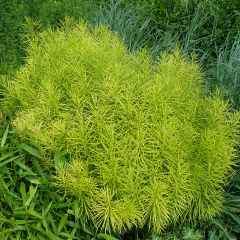
Amsonia hubrichtii
- Flowering time June to August
- Height at maturity 80 cm
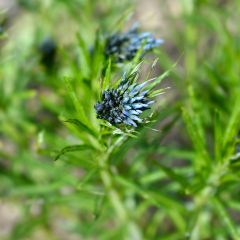
Amsonia ciliata Ernst Pagels
- Flowering time July, August
- Height at maturity 1 m
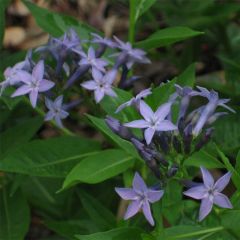
Amsonia orientalis
- Flowering time August to October
- Height at maturity 1 m
Discover other Amsonia
View all →Available in 3 sizes
Available in 1 sizes
Available in 1 sizes
Available in 1 sizes
Available in 1 sizes
Available in 1 sizes
Available in 1 sizes
Planting
Where to plant Amsonia?
Very hardy down to -25°C, Amsonia acclimatises without problem in any garden, one of the perennials most resistant to cold! It will probably struggle more in Mediterranean climate, too dry and hot in summer. Its only requirement is soil that does not dry out in summer.
While it accepts any good garden soil that stays cool, tolerating calcareous and even sandy soils, it will perform better in loamy, rich, well-drained and fairly light soil.
It can withstand summer heat and drought if soil remains slightly moist and cool. In winter, however, roots will not tolerate excess water that could encourage fungal diseases.
It prefers non-scorching sun or light shade. Needs a few hours’ sunshine per day for optimal flowering.
A vigorous perennial, rather suited to planting in meadow-style beds, or to lighten flowerings in mixed borders, provided soil never dries out in summer. It will also find a place at woodland edge, under deciduous trees that will give welcome shade.
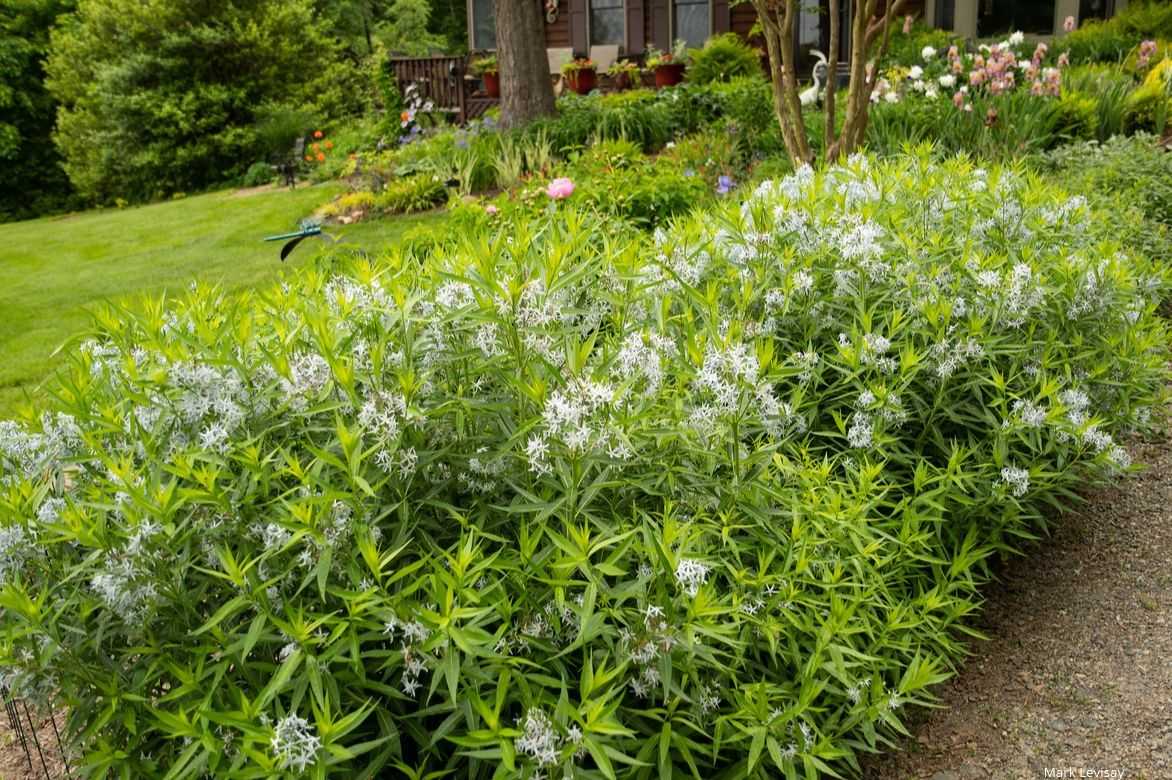
Border of Amsonia tabernaemontana var. salicifolia
When to plant?
Plant Amsonia in your garden preferably between February and April, but you can also plant in autumn from September to November.
How to plant?
Planting in small groups creates a nice effect in a bed; plant Amsonias in groups of 3 to 6 buckets per m², spaced about 30 to 50 cm apart depending on size at ripeness. This perennial declines in soil that is too wet in winter: in heavy or clay soil, add gravel or coarse sand to improve drainage.
- Soak rootball in a bucket before planting
- Dig and fork soil well to loosen it
- Make a hole 2 to 3 times larger than rootball
- Spread gravel or clay pebbles at bottom of hole
- Enrich soil if needed with some compost
- Place rootball and refill without burying the collar
- Firm gently then water copiously
- Mulch to keep soil cool
- Water regularly for first weeks to encourage establishment
More advice on how to plant a perennial on our blog!
Care and maintenance
Hardy and vigorous, Amsonia will prove reliable and generous provided soil remains cool and it is left undisturbed!
Mulch the base from May with a good layer of organic mulch to keep soil cool at the roots and water regularly for the first weeks and throughout the first summer after planting to prevent the soil drying out. Thereafter, water mainly during prolonged hot spells. As it ages it will become more drought-tolerant. Let it establish without further disturbance and avoid soils that are too wet in winter.
A simple tidy-up of the clump is sufficient: cut the clump back in late winter, between February and March. In winter the plant disappears completely: consider marking its position.
Amsonia is a robust perennial that suffers from no diseases.
Propagation: sowing, cutting, division
Amsonia multiplies very easily by division of clumps in spring or early autumn, by sowing under cover in spring and by propagation by cuttings in early summer. We recommend division, as sowing is unpredictable.
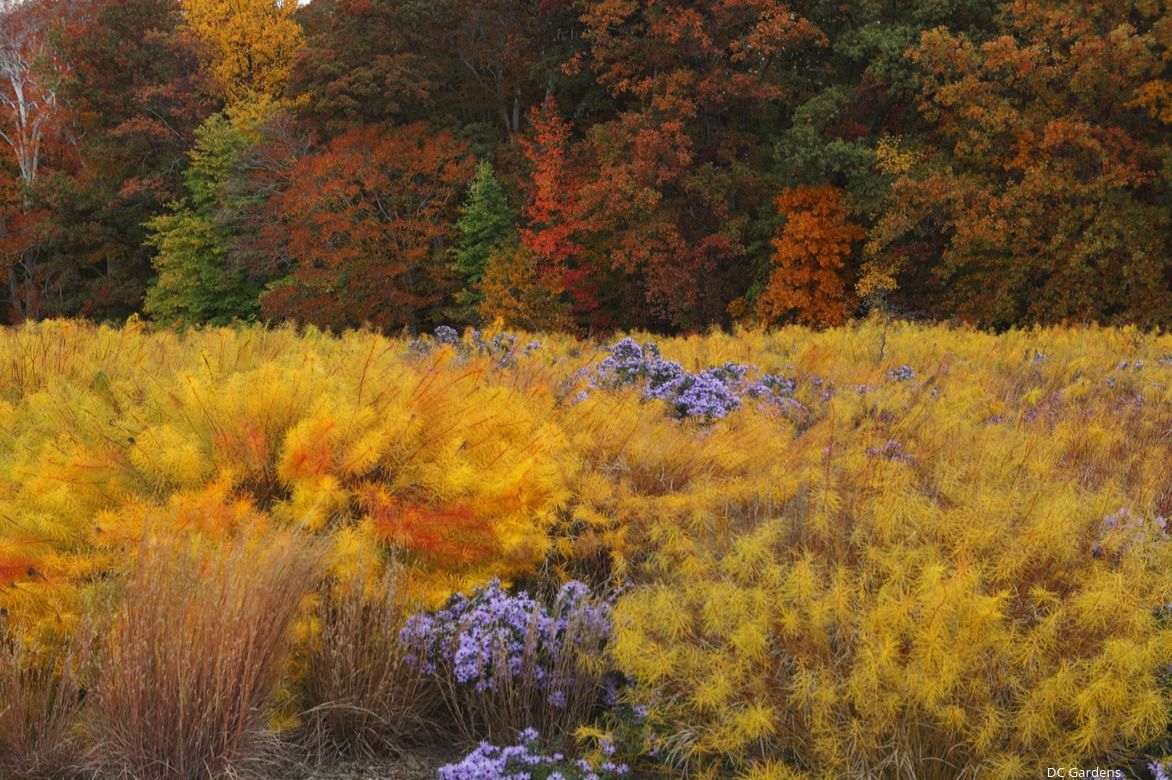 Stunning colours of Amsonia hubrichtii in autumn!
Stunning colours of Amsonia hubrichtii in autumn!
Division
Divide Amsonia’s woody stump about every four years once well established.
- Choose a healthy clump
- With a well-sharpened spade, slice off several divisions around the perimeter
- Replant immediately in garden at chosen location in well-prepared soil
Propagation by cuttings
- In summer, take semi-woody stems about 15 cm long and plant them in buckets in a moist sandy potting compost mix
- Firm compost around each cutting
- Place the cuttings in a sealed plastic bag to encourage rooting
- Pot on in autumn or following spring after risk of frost has passed
Sowing
In favourable conditions, Amsonia propagates by spontaneous sowing. If, however, you wish to multiply it by seed, nothing could be simpler.
- Sow seeds collected after flowering in a seed tray under a cold frame in winter or very early spring on surface of a good free-draining potting compost
- Pot up the seedlings into individual buckets
- Plant young plants in garden once risk of frost has passed
- Water well to ensure establishment
Discover our tips and tricks to succeed with sowing seeds on our blog!
Companion plants for Amsonia
Amsonias are among those perennial plants perfect for brightening sunny or shaded areas of garden in companion with other summer-flowering perennials. With their both bushy and airy habit, and their pale blue flowering, they bring lightness and country charm to natural-style gardens and contribute to charm of romantic gardens. Planted in small groups, they create moving, wild-looking scenes and fit into cool colour harmonies of blue or white or into more complementary blue/yellow combinations.
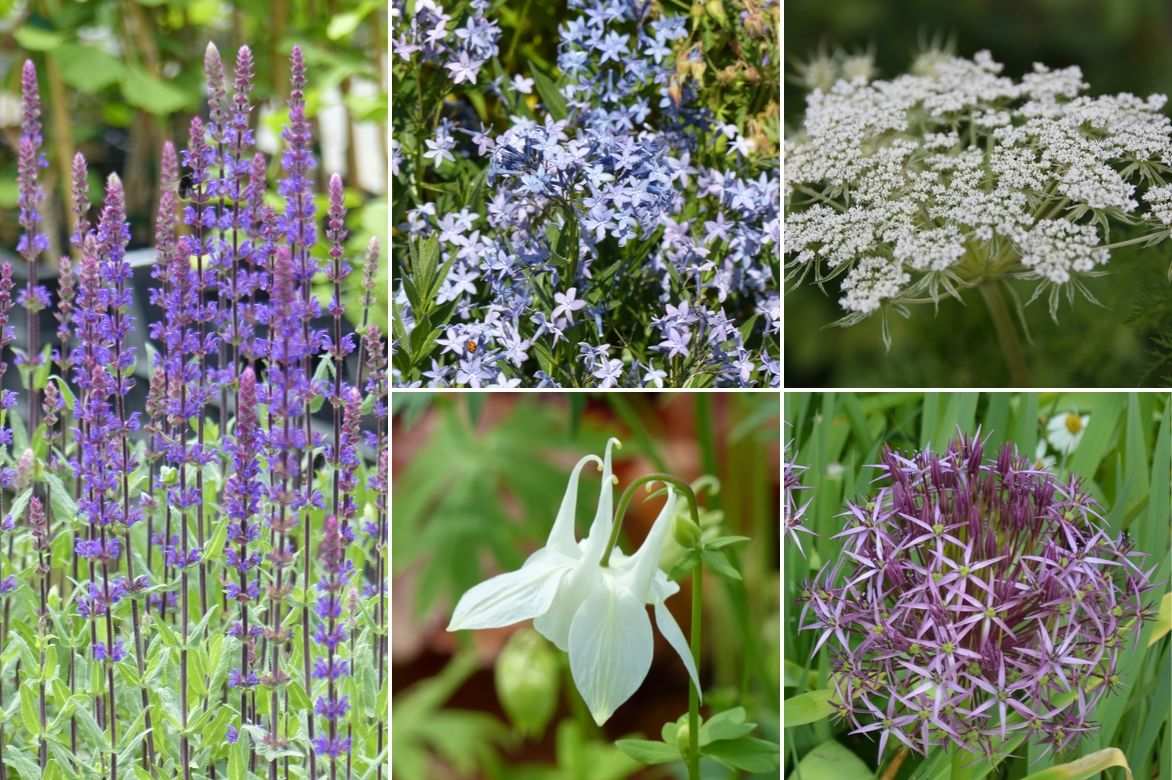
An example of pairing: Salvia nemorosa ‘Caradonna’, Amsonia orientalis, Selinum wallichianum (or Cenolophium denudatum), Aquilegia vulgaris ‘Munstead White’ and Allium christophii
For a delicate, romantic atmosphere, plant a few clumps of Amsonia with shrub roses, peonies, whose often bare, unsightly bases they will hide, Agapanthus or Calamintha.
Soothing, luminous blue of flowers, as well as their abundance, will give a fresh, charming touch in a blue garden, alongside ageratum, bellflowers, salvias with blue flowers, gentians, hardy geraniums such as ‘Blue Cloud’, ‘Azure Rush’, Nepeta manchuriensis ‘Manchu Blue’, Polemonium reptans ‘Blue Pearl’, irises …
In bolder combinations, the azure tone of its flowers will contrast with yellow, red or orange flowers of summer-flowering perennials, such as daylilies, avens, alchemilla, lupins, Kniphofias, rudbeckias, Welsh poppies.
They will bring a fresh note to a loose-textured perennial border with paniculate phlox, agastaches, Eupatorium coelestinum, loosestrifes, vernonias, tansy ‘Isla Gold’, or perennials for moist soil such as astrances and camassias.
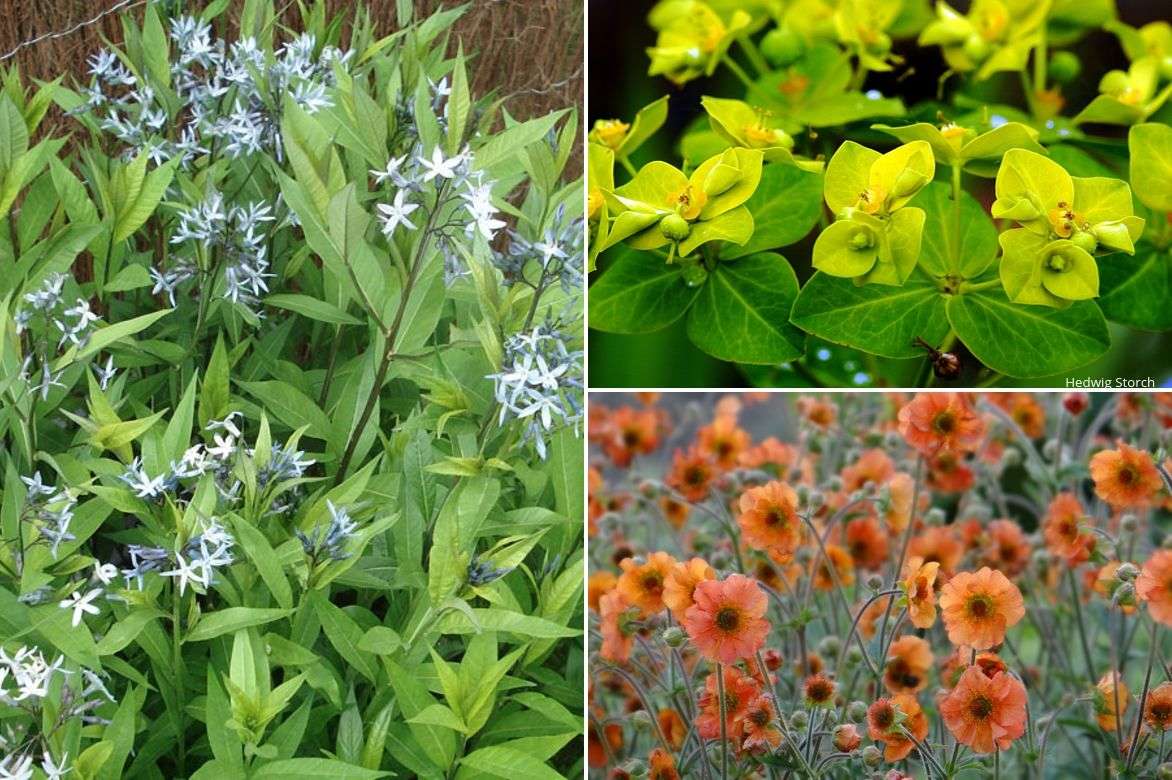
An example of a contrasting pairing: Amsonia tabernaemontana var. salicifolia, Euphorbia cornigera ‘Goldener Turm’ and Geum ‘Totally Tangerine’
In a late-summer scene, they will keep company with Japanese anemones, and asters that will take over flowering into autumn.
Moist-soil grasses such as Japanese grasses (‘All Gold’) or Miscanthus with colourful autumn foliage (‘Graziella’, ‘Purpurescens’) will complement the beautiful golden and copper tones of Amsonia’s autumn foliage.
→ Discover other pairing ideas with Amsonia in our advice sheet!
Useful resources
- Discover our selection of perennials for moist to wet soils!
- How to ruin planting your perennials in 6 lessons?
- Subscribe!
- Contents
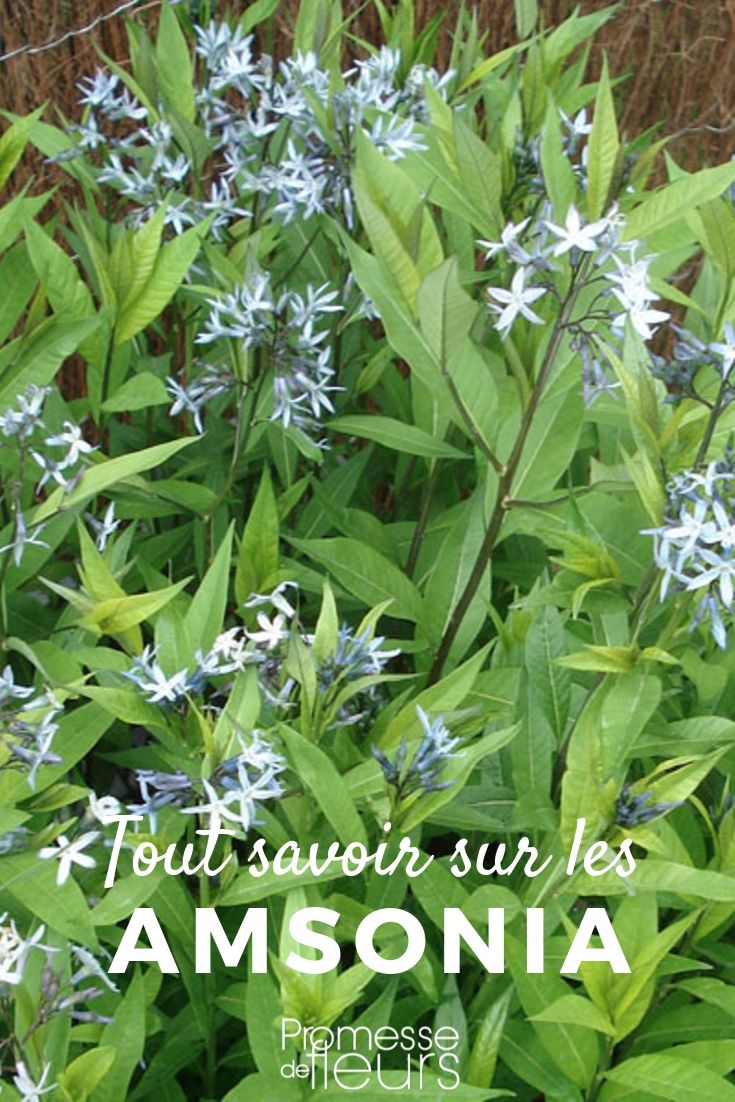
































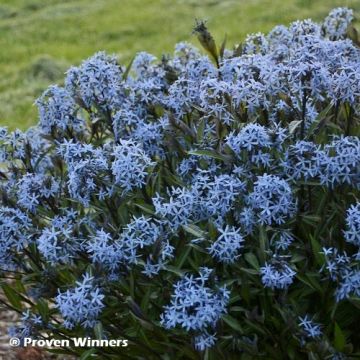





Comments